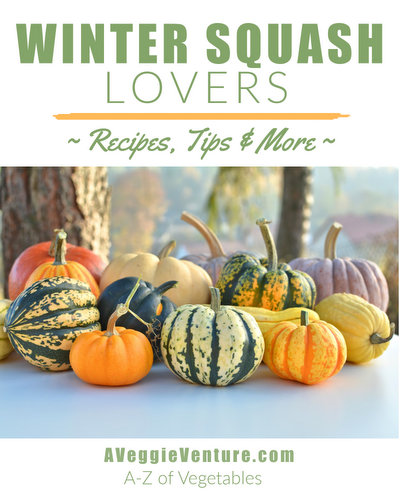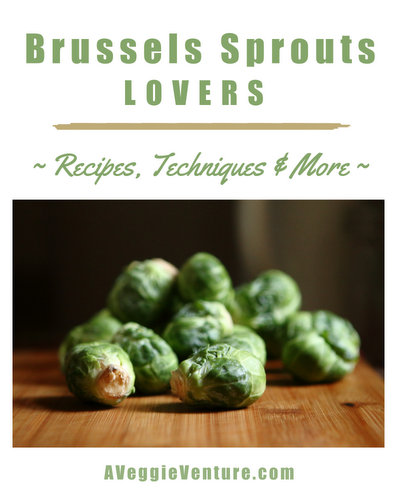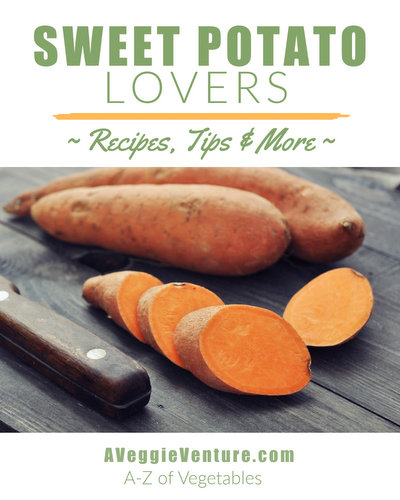The Miracle of Squash Blossoms

"I blog, therefore I learn. I learn, therefore I blog." That's been my yin-yang mantra here at A Veggie Venture since 2005, a long time ago in blogging years! So hey, let's learn about squash blossoms, shall we? Now I'm not the gardener, I'm not the farmgirl, this is just me, a curious cook, learning a little bit more about the plants emerging from the garden – learn with me and together we'll never take a "simple" zucchini for granted again!
PHOTO COLLAGE [Top] Two zucchini, the "blossom" ends on the left, the "stem ends" on the right. [Left] Squash blossoms hidden amid the plant's leaves. [Right] Two bees collecting nectar from a male zucchini flower, at the same time gathering pollen.
MALES & FEMALES Squash plants flower with boy squash blossoms and girl squash blossoms. Squash plants produce more boys than girls but just like in humans, it's the girls who bear the "babies" - the fruit of the plant, what we cooks call zucchini and other kinds of squash. (Aha! This actually makes the Famous Zucchini Baby even more funny than it already is! That shot is from Iron Stef, a fellow St. Louis food blogger. From now on, for simplicity, I'm going to call that fruit, that baby, "zucchini".)
BUT HOW DO WE TELL THE DIFFERENCE? Squash plants produce "male" flowers on its older growth, "female" flowers on its newer growth. At the base of the male flowers is a stem, no more. At the base of the female flowers is, small at first, a zucchini! (This photo shows a side-by-side comparison.) In my collage, we can tell that the top flowers are "females" because they have zucchini attached, the bottom flowers are "males" because they don't. I gotta say, that was a lucky break; grade-school science was a long time ago!
NOW GO LOOK! So get a zucchini from the fridge. It's easy to identify the stem end, yes? At the other end? There was once a squash blossom! That's why I some times call it the "blossom end". We'll never again forget, yes?! I always trim off the blossom end, it's rough surface can harbor gunk we'd rather not eat.
THE BEAUTY OF BEES When the squash plants begin to blossom, bees buzz around the garden, bustling here, billowing there, searching for nectar. The bees' chances at getting lucky are extra good in the morning, when the squash blossoms open up. When bees visit a male flower, get down deep inside it, they pick up messy pollen. [The rest of this paragraph is updated & corrected thanks to an anonymous commenter, thank you!] Then when they get to the female flowers, the bees wipe their feet on her rug (oh gad), leaving the male flower's pollen behind and pollinating the female flower. The male and female DNA combine to produce a fertilized egg which develops into a seed. Then, germination occurs, this is when the seed coat breaks open and the germ inside begins to grow, producing that fruit, aka zucchini. In hot weather, this takes only four to eight days!
MULTIPLE "BIRTHS" PER SEASON The reason squash plants are notoriously prolific is because when we harvest the zucchini, the plant will put out new shoots with new flowers and new flowers means new zucchini. If we don't harvest the zucchini, the plant will put all its energy into its existing zucchini, that's how some zucchini and other summer squash get soooo large.
ARE SQUASH BLOSSOMS EDIBLE? Yes! But squash blossoms are delicate and highly perishable – so delicate and perishable you won't find any in the grocery store, at least in the U.S. When you find squash blossoms at the market, use them the same day. Or – here's a trick from my friend Genie, the The Inadvertent Gardener, how to buy a day, if you can't use squash blossoms right away. Put the squash blossoms in a paper bag, blow it full of air, tie off the top and leave it in the fridge. They’ll be good for one more day.
WHAT ARE WE EATING? Like the bees, we don't really care if the blossoms we eat are male or female, they taste the same. But chances are, the squash blossoms you might find in the farmers market are male squash blossoms because when gardeners harvest the females, no more zucchini.
SUMMER SQUASH vs WINTER SQUASH This whole process works the same in summer squash, those are the tender-skinned squash we call zucchini, yellow squash, crookneck squash, pattypan squash, etc. Their skins are tender because they are harvested when immature, before their skins harden, in summer and early fall. In contrast, winter squash like butternut squash, acorn squash and my favorite squash for homemade pumpkin purée, the kabocha squash, are all harvested later in the season and thus are more mature and have thicker, tougher and inedible skins.
SO THAT'S IT I learned something and I hope you did too! Gardeners and botanists, what would you add in? Please chime in!
SQUASH BLOSSOM EPHEMERA
The Squash Blossoms, the folk group from Johnsonville, Tennessee.
Squash Blossom Necklace, I don't "see" squash blossom in this but sure, yeah, it's pretty!
RECIPES
Simple Pattypan Squash with Squash Blossoms from A Veggie Venture.
Summer Squash Recipes from A Veggie Venture.
Five Ways to Eat Squash Blossoms from the ever-inspiring The Kitchn.
Gather Ye Squash Blossoms While Ye May on NPR by Susan Chang.
Squash Blossom Quesadilla from Homesick Texan.
A Veggie Venture is home of zucchini lover and 'veggie evangelist' Alanna Kellogg and the
famous asparagus-to-zucchini Alphabet of Vegetables.
© Copyright Kitchen Parade 2012
famous asparagus-to-zucchini Alphabet of Vegetables.
© Copyright Kitchen Parade 2012




Hello lovely! I adore squash blossoms and used them quite a bit while living in Italy;). Especially stuffed with cheese and herbs and lightly fried... or in frittata or risottos... ;)
ReplyDeleteEons ago a city-girl friend of mine planted her very first garden. She planted about 2 dozen zucchini plants because she thought they would only produce one zucchini per plant... 8'O
ReplyDeleteThe garden got so overgrown with tangled vines and huge leaves that some fruits were missed until they got big enough to walk out on their own. One in particular was enormous, weighing nearly 20 pounds. My friend described it as being as big as her thigh. Ever since, all those huge zucchinis have been referred to around here as "green thighs".
Janelle ~ Hello luv-ily! I've actually never had the blossoms stuffed, maybe some time you can do that for me! :-)
ReplyDeleteFeatheredGems ~ Hilarious! Green Thighs? Chuckle, chuckle!
Just one small mistake in the botany lesson. Pollen doesn't germinate. Germination occurs when the seed coat breaks open and the germ begins to grow. The pollen pollenates the female flower. That is it's DNA combines with the female's DNA to produce a fertilized egg which developes into a seed.
ReplyDeleteAnoymous ~ Thanks for the correction!
ReplyDeleteNice botany lesson! I'm not a huge gardener, but I do have a few plants, and zucchini is one of them. I've never used the blossoms before - looking forward to trying it. And I'm looking forward to all those teeny squash I'll be picking so the plants keep on producing (plus the smaller ones taste better). Great post - thanks.
ReplyDeleteHere's something to add in to your article: CROSS POLLINATION Like squash, Pumpkin, and gourds, they are all apart of the Cucurbit Family. This allows you to be able to take pollen from a male squash flower and fertilize a female zucchini flower and it will not affect the taste, texture, or storing habits of the zucchini fruit. BUT if you plan on saving those seeds, you will not get a zucchini plant when you plant it in the ground. You will get a HYBRID PLANT WITH FRUIT THAT HAS BOTH THE QUALITIES OF A SQUASH AND ZUCCHINI PLANT. So if you or a neighbor are growing different types of plants in the Cucurbit Family and you plan on saving the seeds, you should probably hand pollinate that individual fruit by itself to make sure you'll get that plant again next spring.
ReplyDeleteThis comment has been removed by a blog administrator.
ReplyDeleteThis comment has been removed by a blog administrator.
ReplyDeleteThis comment has been removed by a blog administrator.
ReplyDeleteThis comment has been removed by a blog administrator.
ReplyDeleteThis comment has been removed by a blog administrator.
ReplyDeleteThis comment has been removed by a blog administrator.
ReplyDeleteThis comment has been removed by a blog administrator.
ReplyDeleteThree weeks of male blooms, no females. Then on a separate pot, two small yellow squashes (1/2") at base of female buds, and then another single 1/4" squash on another pot. Checking every day to be ready for hand pollination, since no bees or flutterbyes to speak of any more.
ReplyDeleteAppreciate advice to wait and watch. It worked.
This comment has been removed by a blog administrator.
ReplyDelete